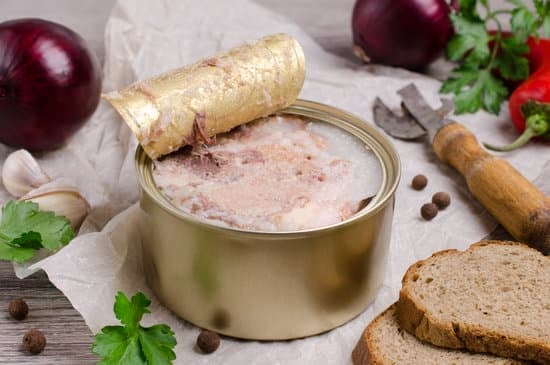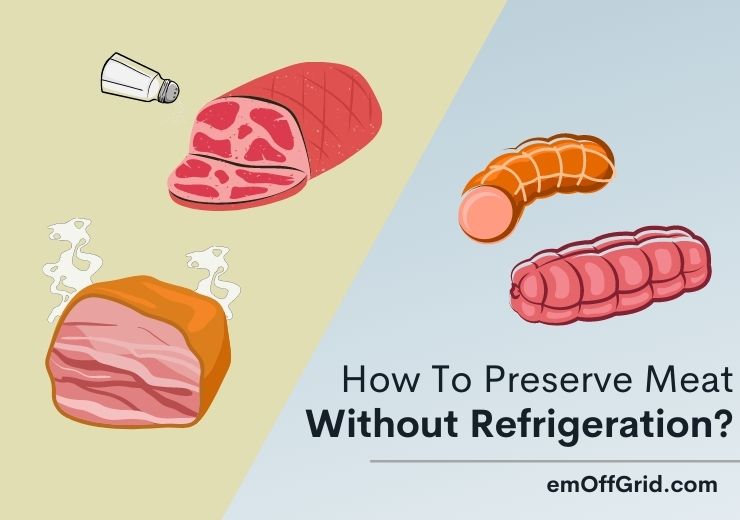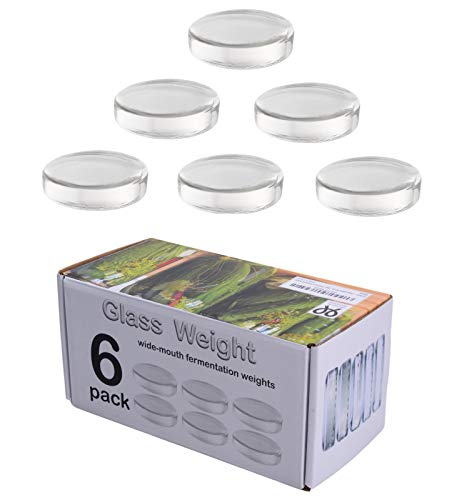New-age technologies like a refrigerator can be found in every home, which has made human life easy.
But unfortunately, even the most advanced technological innovation may fail occasionally. So then the question arises, how do you preserve your meat without refrigeration?
It is crucial to store meat properly if you want to preserve it for later use. In case of a power outage or an equipment failure, you may lose all the contents in your fridge.
This may lead to a serious condition for which you may not have been prepared.
In this article, we will discuss the importance of preserving meat and find out 10 effective ways to preserve meat without refrigeration. So, let’s get started.
Contents
- Why Do You Need to Preserve Meat?
- Preparing To Preserve Meat
- 10 Ways To Preserve Meat Without Refrigeration
- Preserving Meat By Drying (Dehydrating)
- Preserving Meat By Curing With Salt
- Preserving Meat By Canning
- Preserving Meat By Brining
- Preserving Meat By Biltong
- Preserving Meat By Lard
- Preserving Meat By Using The Weather To Your Advantage
- Preserving Meat By Smoking
- Preserving Meat by Sugar Syrup
- Preserving Meat by Using Preservatives
- Final Thoughts
Why Do You Need to Preserve Meat?

Preservation of meat helps slow down microbial growth, decrease enzymatic activity, and prevents fatty acid oxidation, which promotes rancidity.
By using the correct preservation techniques, we can store the texture and taste of meat for a longer period of time.
Storing meat has many benefits, especially for people who have chosen an off-grid lifestyle. From saving cost and time to providing healthier food to your family, it can all be done by preserving your meat.
Even before the modern technological innovations like refrigerators, our ancestors had developed creative ways to keep their meats from spoiling. So, yes, it is possible to store meat without a refrigerator.
Some of the most common methods known for food preservation include
- Drying/Dehydrating Meat
- Canning
- Curing
- Smoking
- Brining etc.
Preparing To Preserve Meat
Meat preservation is a technique that needs some preparation and practice. We just cannot cut the meat and preserve it. So, it is highly essential to discuss the preparation to preserve meat.
Preparing Meat
Clean and fresh meat will ensure a more successful preservation process. Fresh meat is generally hot and needs rapidly cooling for preservation.
To cool the meat rapidly, remove the connective fat, connective tissue, and natural bone insulators during the cleaning process.
Slice the meat into tiny pieces immediately to allow the heat to dissipate quickly. Simultaneously wash the meat thoroughly using water and keep it in a storage bag after draining all the water.
Preparing Tools
Use of a clean and sterilized tool is highly essential in the preservation process. Fresh meat can easily attract microbes, and unsterilized tools are one such source.
Clean tools will not only protect your meat, but they will also ensure safety and hygiene.
10 Ways To Preserve Meat Without Refrigeration
The whole idea of meat preservation is to prevent it from getting spoiled and maintaining its texture and taste for a prolonged period.
The growth of microorganisms on meat is highly affected by its inherent properties like pH and moisture content which need to be addressed for meat preservation.
Preservation techniques are mainly based on temperature control, moisture reduction, or by application of some additives.
One or a combination of techniques like canning, curing, smoking, modified atmosphere packing, etc., may be used to preserve meat for a more extended period without using a refrigerator.
In this section, we will discuss 10 such preservation techniques for meat that don’t require electricity or refrigeration.
Preserving Meat By Drying (Dehydrating)

Drying is a chemical-free way to store meat by dehydrating it until it is too dry for microbial action. Dehydrating meat eliminates moisture without losing the nutrients, making it ideal for storage without a refrigerator.
In this method, you need to cut the meat into thin slices to ensure proper drying out of the meat. Apart from traditional sun-drying, you can alternatively use equipment like a dehydrator, if you have access to it.
Maintaining a temperature of 130 to 140 °F during the drying process is considered ideal. Most of the microbes will get destroyed and the meat can be easily stored for a longer period.
Dehydration is one of the simplest and cost-effective methods for meat preservation. It eliminates the need for any chemicals or preservatives.
Tip: Remove the skin and fat from the meat before cutting it into slices. It helps in fast-drying and easy cooking.
Preserving Meat By Curing With Salt

Curing meat with salt is one of the oldest known meat preservation methods. It basically follows the principle of preservation through the removal of moisture.
Moreover, salt naturally helps to prevent the growth of microorganisms in the meat.
To cure meat with salt is very simple in which you need to cover the meat entirely in salt and let the juices drain off completely. Additionally, at this point, you can also add some flavors like herbs and spices if you want.
If you’re worried about wasting so much salt, you can try another method of curing known as equilibrium curing.
In this, you need to evenly apply salt of about 3% of meat’s weight. Then use a vacuum sealer to seal everything up and let it rest for about 5 days.
Curing is specifically suitable for shoulders, hams, and roasts. A temperature range of 35 to 50 ° F is recommended for large cut meat. The only way to tell when the meat is finished curing is to weigh it.
Warning: Any foul odor noticed at any point in the process indicates bacterial growth. There’s no way to salvage the meat after the rot has begun. Simply discard it.
Preserving Meat By Canning

Canning is probably the best method for long-term meat preservation in which the meat is sterilized and sealed in containers.
There is nothing like canned meat to boost your preparedness for the crisis since it can be kept at room temperature for years.
Water baths and pressure canners are the two ways of meat canning, out of which pressure cans are considered more effective in the long run.
Canning is one of the most popular and well-known methods for preserving meat, but it requires some practice to get it right.
It works by heating water and trapping the resulting steam in a pressurized container. This raises the temperature of the container to about 240 ° F or higher, killing any and all bacteria.
6 Pack – Large glass fermentation weights for wide mouth Mason jars
- Keeps your veggies under the brine and submerged.
- Made from high quality lead free, mold free, and BPA free pure soda glass
- Better than ceramic weights. Bacteria cannot hind in non-porous solid glass
Hot Packing
In hot packing, meat is boiled with salt/spices. When the boiled pieces are 2/3rd cooked, it is placed in the jars. The hot broth is poured over the pieces, and the lid is tightly sealed.
Raw Packing
This is a method of canning in which raw meat is cut into cubes, salted, and sealed in a canning jar. Ensure that the lid is vacuum-sealed and then store the can in a cool place.
Even though this method requires a long processing time, it will help you preserve meat for years.
Note: Containers are just as important as the meat. So, make sure you properly prepare a container for storage.
Preserving Meat By Brining

Brining is a very simple and one of the most traditional methods of meat preservation. It is basically a substitute for the pickling process. You can preserve the meat for years if the process is correctly followed.
Brine is simply a mixture of salt, sugar, and water. The meat is soaked in the brine mixture and stored in a cool place at room temperature for several weeks.
Salt gets into the meat and stops bacterial growth while the water keeps it nice and moist.
This process results in a softer texture and provides a robust flavor to the meat. Brining may leave high salt content in the meat, which can be reduced by soaking the meat prior to cooking and draining off the water.
Fun fact: The ideal brine has enough salt to float a raw egg.
Preserving Meat By Biltong

Biltong is a very traditional process for meat preservation that first originated in South African countries. It is quite similar to jerky, which is a more commonly known process in other countries.
In this process, meat is marinated in vinegar – whether white, brown, or apple cider and then air-dried for up to a week by hanging on hooks.
Some spices like black peppercorns, whole coriander, brown sugar, cloves, and rock salt may also be used during the marination process to add distinct flavors.
Vinegar used in biltong not only acts as a curing agent but also helps keep flies off the meat as it dries.
Depending on how you decide to prepare it, biltong meat can be dry and crumbly with no fat or soft and chewy with extra fat on it. The end product is rich in protein and low in carbs, making it a good fit for various diets.
Caution: Biltong has a very high sodium content, which may have a negative impact on heart and blood pressure. So, it should not be consumed above the daily recommended limit.
Preserving Meat By Lard

Lard is another very old-school method of preserving meat. This is specifically a great method for preserving meat that is rich in fat.
In this technique, the meat is layered in a crockpot and covered with melted lard. The lard prevents bacterial growth as it cuts off the air supply to meat. It is a low-cost and efficient way of meat preservation that requires no equipment.
Let’s discuss some most common mixtures used for meat preservation by lard.
Pemmican
Pemmican is made of dried meat, rendered fat, and berries used to preserve meat for long periods of time without refrigeration.
This is a method originally developed by Native American tribes which were later adopted in other parts of the world.
Meat preserved using this method can even withstand extreme temperature conditions. However, the shelf life of pemmican depends on how it is kept and if salt is added. If salt is applied, it may last a little longer.
Note: Adding berries are optional. It adds flavor and carbs but reduces the storage time.
Confit
The term confit comes from the French verb confire, which means to preserve. Traditionally, confit was used to describe any kind of preserved food, including meat, fruit, and vegetables.
Food is preserved by gently heating it in a liquid that is resistant to bacterial development. After cooking, the food is packed into containers and immersed fully in liquid, providing an impenetrable barrier against bacterial growth.
Fun Fact: The actual purpose of fat in a confit is temperature regulation and creating an environment inhospitable to bacterial growth.
Rillettes (Potted Meat)
Rillettes is another classic method of preserving meat that was designed to keep meat fresh and edible even before the invention of refrigeration. This method seems quite similar to confit but is slightly different.
In this method, meat is slowly cooked in its own fat, and then it is shredded, salted, and packed in small pots. Later it is sealed with a layer of the fat (animal fat or oil) to prevent it from getting spoiled.
Pâté
Pâté is basically a French word that means paste in English. It is a meat preservation method that is the same as confit except for the meat that is used.
This method can be used for any type of meat like beef, pork, liver, ham, seafood, wild game, poultry, etc.
Here, a finely or coarsely ground blend of meat, organ meat, herbs, or other seasonings is used. The mixture is then wrapped in suet, other animal fat, or lining.
Fun Fact: Pâté de foie gras is a 2500 BCE old recipe that is prepared from the liver of a goose or duck that has been force-fed until the fat content reaches more than 50%.
Terrine
Terrine is another French word that is entirely different from pâté. Using this method, you can get robust, chunky, and textured meat with strong flavors.
In this method, the meat is grounded and mixed, similar to pâté, but it is further cooked in a covered pottery mold (also called a terrine) in a bain-marie (water bath)—while stored, only animal fat or oil is used and no butter.
Preserving Meat By Using The Weather To Your Advantage
The weather of the area where you live can also be used as an advantage to preserve meat at home for longer durations.
Depending upon the weather, meat can be preserved without electricity or refrigeration using different means.
Cold storage is perfect for meat preservation in places having a very cold climate. Alternatively, a temporary cold cellar or a permanent root cellar can also be used.
Preserving Meat By Smoking

Smoking is one of the oldest meat preservation techniques known to man, and it has been practiced for centuries.
Apart from increasing the shelf-life of meat, this technique has the distinct advantage of making your meat very flavorful.
In this process, meat is first cured primarily with salt and some spices. The meat is then spread over the racks in a smokebox, and cold smoking is carried out at a temperature of 70°F for a long duration.
Once the smoked meat is ready, it can be stored in a cool, dry place for future use. For more details on the smoking process, you may refer to How Does Smoking Cure Meat?
Caution: Smoke contains toxins (carcinogens) that can lead to severe health-related problems.
The Complete Guide to Smoking and Salt Curing
- Burch, Monte (Author)
- English (Publication Language)
- 256 Pages - 09/17/2019 (Publication Date) - Skyhorse (Publisher)
Preserving Meat by Sugar Syrup
Sugar is another food preservative that can be used to preserve foods, including meat, for a longer period of time.
It is similar to pickling but is not very popular due to adverse effects on health owing to high sugar concentration.
In this method, meat is chopped into small pieces and placed in a clean, sterilized mason jar. Then fill up the jar with concentrated sugar syrup and seal it off completely.
Sugar binds to water in food, decreasing the quantity of water available for microbe development.
When food is kept in a concentrated sugar solution, water is sucked out of the food cell and microorganisms, causing them to die.
Caution: Sugar itself attracts moisture, resulting in an environment that can attract microorganisms such as yeast. So, the right concentration of sugar is highly essential.
Preserving Meat by Using Preservatives
Preservatives are an addition to several ancient and modern methods used for meat preservations. It prevents food from getting spoiled and oxidizing quickly without impacting food safety or quality.
Preservation involves adding specific ingredients to foods and packaging them to remain safe and fresh.
For example, preservatives such as nitrites are frequently added to cured/dried meat to prevent botulism as it cures.
You may have come across studies that link nitrates with cancer and advertises nitrate-free meat products.
However, even processed meat products labeled “nitrate-free” may include a plant component (for example, celery powder) containing naturally occurring nitrate.
Note: As per the joint FAO/WHO Expert Committee on Food Additives (JECFA) in 2002, the acceptable daily intake for nitrite is 0.07 milligram per kg of body weight per day.
Tips To Preserve Meat More Successfully?
Here are tips to help you in achieving successful meat preservation:
- Always use fresh meat for preservation. Fresh meat along with correct technique implementation ensures that your meat preservation will be successful.
- Always trust your senses (sight, touch, and smell) while selecting good-quality meat. The color should be bright (not gray, not dark), the texture should be moist and fresh when touched (not sticky), and fresh odor (no strong or pungent smell).
- You need to trust your senses for verifying the results at each stage of the preservation process.
- Maintaining safety and hygiene at each stage of the preservation process is highly essential.
Final Thoughts
We need to stop relying completely on modern luxurious technologies and be prepared for any type of emergencies, be it natural or technical.
Now that you have some basic idea, you can pick up the technique of meat preservation that suits you the best.
If you’re reading this, we’d like to express our gratitude for making us a part of your life and hope that you find the information shared in the article helpful.
If you have any concerns, queries, or feedback, it will be a pleasure to hear from you.


